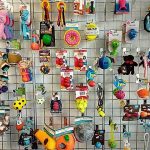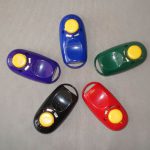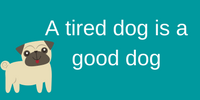The weather outside is frightful, you and your dog are both missing those nice long walks. We can break up the boredom with these three dog games – no special equipment required!
These games are designed to make the dogs think, which is actually just as tiring, if not more exhausting, than physical exercise. Remember back when you were in school? Which was more taxing, a final exam or a soccer game? For most people, the answer is that they’re about the same. Each is tiring in its own way. For dogs, it’s the same. A short brain-game wears out your dog just like a game of “fetch.”
These are all short-session games – no more than a few minutes at a time. You can certainly play more than once a day, but dogs learn better if they’re given a break after any new behavior.
Short and sweet dog games
All of these games can be played with a clicker to “mark” when your dog gets it right. It’s a terrific training tool, and makes timing and consistency a little easier. Whether you use a verbal “yes!” or click – let your dog know when he/she does it right.
Don’t worry about it if your dog doesn’t “get” the game the first time you play. Dogs sometimes need time to process things, according to an article in Psychology Today, and your dog may be one of them. Don’t abandon a game just because he or she doesn’t excel right away. Give it another go and you may be amazed!
Game #1: Touch
You’ll need: a bunch of treats. The plastic lid from some food container. Our favorite is an ice cream pint lid. It’s not really any better than a cottage cheese lid, but we’d rather have an empty ice cream than an empty cottage cheese.
Instructions: Hold the lid in front of your dog. When he/she touches it with his/her nose, say “good touch” and give him a treat. Move the lid to the other hand. Repeat!
The tricky part is transferring it to other places, other circumstances, and “fading” the lid. So try it in another room. If somebody else is around, have them try it.
Game #2: Hide and seek
Did you know dogs can play it, too? It’s easier if you have two people, but you can certainly play with just you and your dog. If you have somebody else around, have that person hold your dog’s collar. Meanwhile, you grab a handful of treats and go “hide.” It can be anywhere in the house – even the bathtub! If you’re alone with your dog, drop a few treats where she’s sitting and, while she’s chomping them up, go hide (be sure to bring treats with you!) When you’re in your hiding place, call your dog’s name one time. Celebrate when she finds you! A good game of tug can be as much of a reward as treats.
Game #3: Switch
Does your dog have a favorite toy? One that’s the best toy in the whole wide world and when it gets destroyed (we won’t mention any culprits by name) you run around frantically looking for a replacement? We did, too, until we learned this game.

Get two toys (or more), not including the “favorite.” Start playing “tug” with your dog. If he seems not “into” it at first – be annoying! That’s how puppies get older dogs to play with them, as we’ve learned in the last couple of months with Simon. Wiggle the toy at their feet. Give them a gentle push. Blow in their face. If your dog has any kind of “prey drive,” undulate the toy across the floor. Sooner or later one of these tactics will annoy your dog sufficiently that he’ll “give up” and play with you.
When he’s truly into the game, drop the toy you’re tugging with, grab one of the others, and tell him “I wanna play with this one now!” And start being annoying. Pay no attention to the first toy until he grabs the second one.
Keep switching!
If your dog runs away to play with the toy by himself, it’s up to you how you treat it. On the one hand, you’re happy he’s playing with a different toy. One the other hand, he’s supposed to be playing with you! If you want him to play with you, just pester the dickens out of him until you have his attention back and the game can continue.
Conclusion
It doesn’t take a lot of time, special training, or complicated equipment to play interactive games with your dog. It just takes a little energy, some stuff you have around the house, a minute of planning, and the will to do it. If your dog is stricken with cabin fever and driving you crazy, these games will help take the edge off and restore peace and quiet.
These ideas will get you started. What other “indoor games” do you play with your dog?










